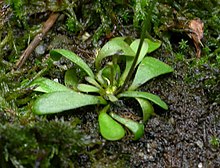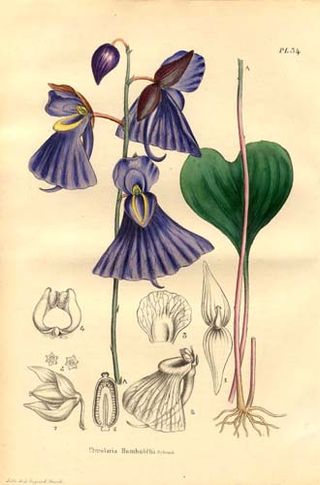
Lentibulariaceae is a family of carnivorous plants containing three genera: Genlisea, the corkscrew plants; Pinguicula, the butterworts; and Utricularia, the bladderworts.

Genlisea is a genus of carnivorous plants also known as corkscrew plants. The 30 or so species grow in wet terrestrial to semi-aquatic environments distributed throughout Africa and Central and South America. The plants use highly modified underground leaves to attract, trap and digest minute microfauna, particularly protozoans. Although suggested a century earlier by Charles Darwin, carnivory in the genus was not proven until 1998.
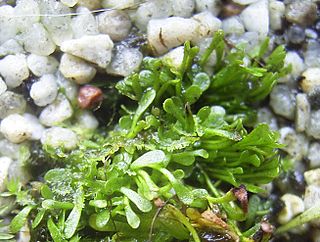
Genlisea aurea is one of the largest carnivorous species in the genus Genlisea. It has pale bundles of root-like organs up to about 15 cm long under ground that attract, trap, and digest protozoans. These organs are subterranean leaves, which lack chlorophyll. G. aurea is endemic to Brazil, where it grows with several other species of Genlisea. It possesses an exceptionally small genome for a flowering plant.
Genlisea margaretae is a carnivorous species in the genus Genlisea native to areas of Madagascar, Tanzania, and Zambia. It has pale bundles of root-like organs up to about 20 cm long under ground that attract, trap, and digest protozoans. These organs are subterranean leaves, which lack chlorophyll. It had been known to possess the smallest known genome of any flowering plant as of 2006, but was later surpassed by the related species Genlisea tuberosa.

The perennial vine Lonicera hispidula is a species of honeysuckle known as pink honeysuckle and, less often, California honeysuckle. It is a low-elevation woodlands shrub or vine found on the West Coast of North America.
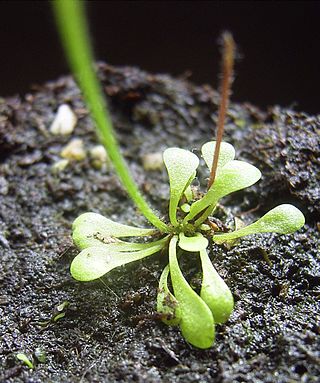
Genlisea lobata is a corkscrew plant native to Brazil.

Genlisea pygmaea is a corkscrew plant native to South America.

Genlisea repens is a corkscrew plant native to South America.

Genlisea violacea is a corkscrew plant native to South America.

Genlisea subglabra is a corkscrew plant native to Africa.
Peter Geoffrey Taylor (1926–2011) was a British botanist who worked at Royal Botanic Gardens, Kew throughout his career in botany. Taylor was born in 1926 and joined the staff of the herbarium at Kew in 1948. He published his first new species, Utricularia pentadactyla, in 1954. In 1973, Taylor was appointed curator of the orchid division of the herbarium and, according to Kew, "under his direction, orchid taxonomy was revitalised and its horticultural contacts strengthened."

Arctostaphylos hispidula is a species of manzanita known by the common names Gasquet manzanita and Howell's manzanita. It is native to the coastal mountain ranges of southern Oregon and northern California, where it is an uncommon member of the serpentine soils flora and other mountain plant communities. This is a spreading or erect shrub reaching a maximum height between one and two meters. The twigs and foliage are bristly and glandular, the dark green leaves oval to broadly lance-shaped and up to 3 centimeters long. The shrub blooms in crowded inflorescences of urn-shaped flowers and produces whitish to tan colored drupes each 5 to 7 millimeters wide.

Gaultheria hispidula, commonly known as the creeping snowberry or moxie-plum, and known to Micmaq tribes of Newfoundland as Manna Teaberry, is a perennial spreading ground-level vine of the heath family Ericaceae. It is native to North America and produces small white edible berries. It fruits from August to September. Its leaves and berries taste and smell like wintergreen.

Genlisea filiformis is a species of carnivorous plant in the genus Genlisea. It is native throughout the majority of South America, several countries in Mesoamerica, and the Caribbean.
Genlisea africana is a species of carnivorous plant in the genus Genlisea. It is native to Zimbabwe. The species was first described by the botanist Daniel Oliver in 1865.

Synandra is a monotypic genus of flowering plants in the mint family containing the single species Synandra hispidula, which is known by the common name Guyandotte beauty. It is native to the east-central United States where it ranges from southern Illinois to western North Carolina and Virginia.
Genlisea tuberosa is a carnivorous species in the genus Genlisea that is endemic to Brazil and found only in campos rupestres vegetation. Lacking any roots, it has unpigmented bundles of "rootlike" subterranean organs, technically leaves, which attract, trap, and digest protozoans. This species is unique in the genus in its formation of tubers. As of 2014, Genlisea tuberosa has the smallest known genome of any flowering plant, at 61 Mbp, or 61,000,000 base pairs.
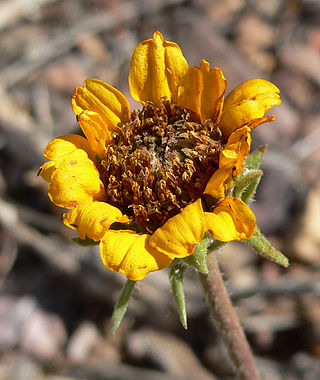
Balsamorhiza hispidula is a North American species of plants in the sunflower tribe within the aster family. It is native to western United States, primarily the Great Basin and other dry, relatively flat terrain. It has been found in Idaho, Montana, Wyoming, Oregon, Nevada, Colorado, Utah, and Arizona.

Pultenaea hispidula, commonly known as rusty bush-pea, is a species of flowering plant in the family Fabaceae and is endemic to south-eastern continental Australia. It is an erect, spreading shrub with many drooping branches, oblong to egg-shaped leaves with the narrower end towards the base, and yellow to pale orange and red flowers.
